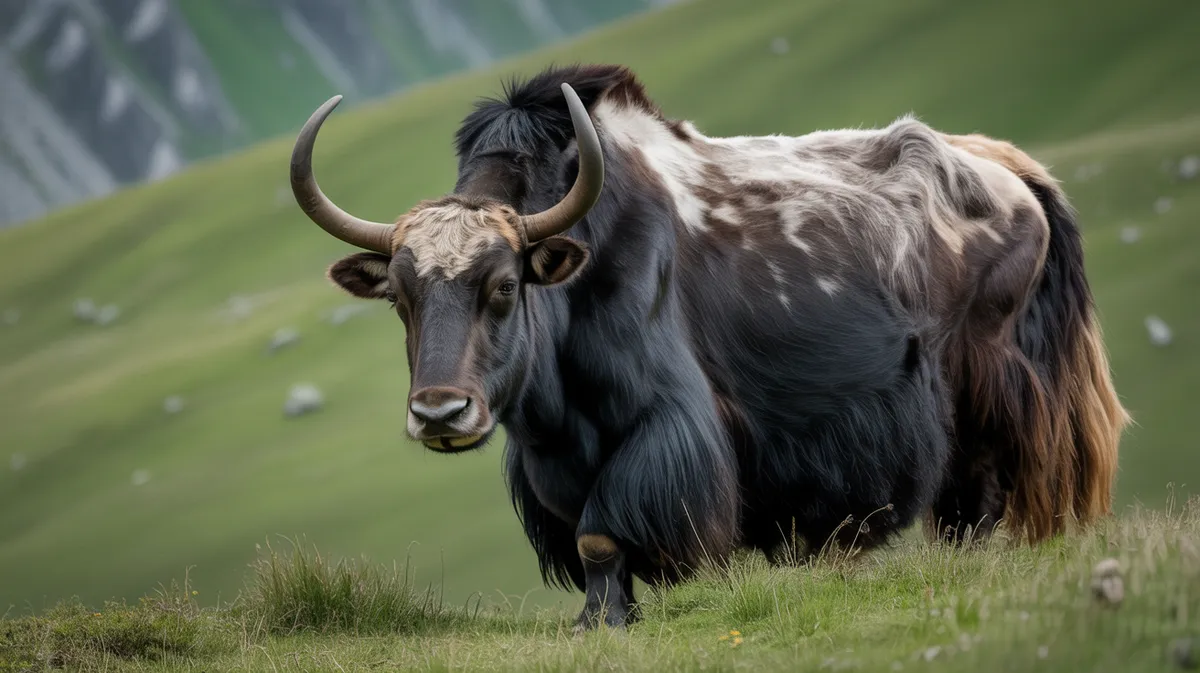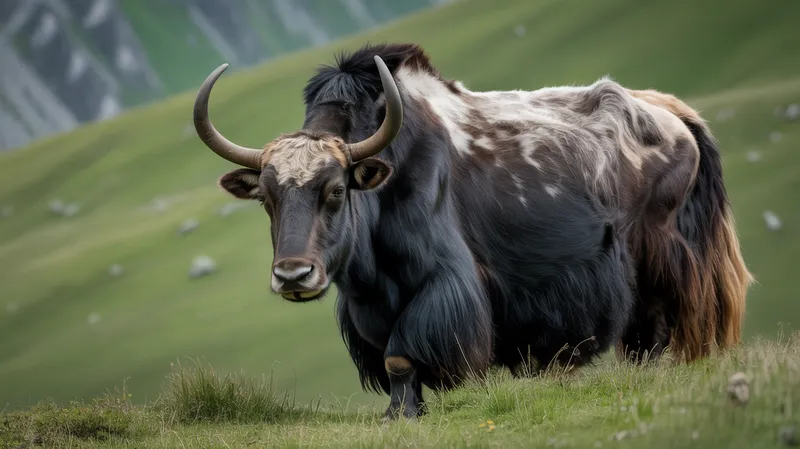
Domestic Yak
Bos grunniens

Meet the Domestic Yak
The domestic yak is a large, long-haired bovine native to the high-altitude regions of the Himalayas and Central Asia. Adapted to cold mountainous environments, yaks possess a thick woolly coat and large lungs that help them thrive at elevations above 3,000 meters. They are integral to the livelihoods of people living in Tibet, Nepal, Mongolia, and surrounding areas, providing milk, meat, wool, and serving as pack animals. Yaks are known for their gentle temperament and impressive stamina, allowing them to navigate rugged terrain with ease.
Classification
Mammal
Habitat
Mountain grasslands and alpine meadows
Diet
Herbivore
Lifespan
15-25 years
Conservation
Domesticated: Not Evaluated; Wild Yak: Vulnerable
Weight
300-1,000 kg
📖Fascinating Facts
High-Altitude Specialist
Yaks are perfectly adapted to life at high altitudes, with specialized blood cells that efficiently carry oxygen even in thin mountain air.
Warm Wool
Yak wool is prized for being warmer and softer than sheep's wool, and is commonly used to make clothing and blankets in Himalayan regions.
Vital Livestock
For centuries, yaks have been essential to Himalayan peoples, providing not only food and fiber, but also serving as reliable pack animals across treacherous terrain.
📋Detailed Description
The domestic yak (Bos grunniens) is a robust, large-bodied bovid distinguished by its dense, shaggy coat, which provides insulation against the extreme cold of high-altitude environments. Adult males typically weigh between 350–580 kg, while females are smaller, averaging 225–255 kg. Yaks possess a pronounced dorsal hump, sturdy limbs, and broad hooves adapted for traversing rocky, uneven terrain. Their lungs and hearts are significantly larger relative to body size compared to lowland cattle, facilitating efficient oxygen uptake in hypoxic conditions above 3,000 meters. The undercoat consists of fine, insulating wool, overlaid by long, coarse guard hairs that repel moisture and wind. Yaks are social animals, forming herds that can range from small family groups to aggregations of several hundred individuals, especially during seasonal migrations. Their vocalizations are characterized by deep grunts, hence the name 'grunting ox.' Yaks are primarily grazers, feeding on a variety of alpine grasses, sedges, and herbs, but will browse shrubs when forage is scarce. Their digestive system is highly efficient, allowing them to extract nutrients from coarse, fibrous vegetation. Domesticated yaks are integral to the livelihoods of high-altitude pastoralists, valued for their milk, meat, fiber, dung (used as fuel), and as pack animals capable of carrying loads over long distances in rugged terrain.
💡 Did you know?
Unlike most cattle, yaks rarely sweat, which helps them conserve heat in their frigid habitats.
🔬Research & Sources
Wikipedia Summary
The yak, also known as the Tartary ox, grunting ox, hairy cattle, or domestic yak, is a species of long-haired domesticated cattle found throughout the Himalayan region, the Tibetan Plateau, Tajikistan, the Pamir Mountains, and as far north as Mongolia and Siberia. It is descended from the wild yak.
Last Modified: 6/6/2025
🎭Behavior & Social Structure
Domestic yaks exhibit diurnal activity patterns, with peak foraging occurring in the early morning and late afternoon. Herds are generally matriarchal, led by older females, while males may form bachelor groups or remain solitary outside the breeding season. Social grooming and close physical contact help maintain group cohesion and reduce parasite loads. Yaks are non-territorial but may defend access to preferred grazing areas. They are adept at navigating steep slopes and can swim across rivers when necessary. Feeding behavior is characterized by selective grazing, with a preference for nutrient-rich alpine grasses. During harsh winters, yaks use their horns and hooves to dig through snow to reach buried forage. Aggression is rare but may occur between males during the rut or when resources are limited. Yaks communicate through a repertoire of grunts, snorts, and body language, including head tossing and pawing the ground.
👶Reproduction & Life Cycle
Yaks are seasonal breeders, with mating typically occurring from July to September. Females exhibit estrus for 2–4 days, during which dominant males compete for mating opportunities, often engaging in displays and physical contests. Gestation lasts approximately 257–270 days (about 8–9 months), with calving synchronized to occur in late spring or early summer, maximizing calf survival. Females usually give birth to a single calf, which weighs 11–16 kg at birth. Calves are precocial, standing and nursing within an hour of birth. Maternal care is pronounced; mothers are protective and nurse their young for up to a year. Sexual maturity is reached at 3–4 years for females and 5–6 years for males. Lifespan in domesticated settings can reach 20 years, though productivity declines after 12–15 years.
🛡️Adaptations & Survival
Yaks are uniquely adapted to cold, hypoxic environments. Their thick, multi-layered coat minimizes heat loss, while a compact body shape reduces surface area exposure. Enlarged lungs and heart, along with increased capillary density, enhance oxygen transport and utilization. Hemoglobin in yak blood has a higher affinity for oxygen, facilitating survival at altitudes exceeding 5,000 meters. Their rumen microbiota is specialized for fermenting coarse, low-nutrient forage, allowing efficient energy extraction. Yaks exhibit behavioral adaptations such as huddling for warmth and seasonal altitudinal migrations to optimize forage availability. Their hooves are broad and flexible, providing stability on snow and rocky ground.
🎨Cultural Significance
Yaks hold profound cultural and economic importance for Himalayan and Central Asian peoples. They are central to the livelihoods of Tibetan, Sherpa, Mongolian, and other high-altitude communities, providing milk (used for butter and cheese), meat, hides, and fiber. Yak dung is a vital fuel source in treeless regions. Yaks are featured in local folklore, religious rituals, and festivals, symbolizing strength, endurance, and prosperity. In Tibetan Buddhism, yaks are considered auspicious animals, and their horns and hair are used in ceremonial objects. Yak racing and beauty contests are popular in some regions, reflecting their deep integration into local traditions.
🔬Recent Research & Discoveries
Recent genetic studies have clarified the domestication history of yaks, indicating a single domestication event from wild yaks approximately 7,000–10,000 years ago on the Tibetan Plateau. Ongoing research focuses on yak physiology, particularly adaptations to hypoxia, which have biomedical relevance for understanding human high-altitude diseases. Studies on yak microbiomes are revealing unique rumen bacteria that facilitate digestion of lignin-rich alpine plants. Conservation genetics is being applied to monitor genetic diversity and prevent inbreeding in isolated domestic populations. There is also increasing interest in yak-derived products (e.g., fiber, milk) for sustainable agriculture and niche markets.
🎥Wildlife Videos

In the Himalayas alongside the last nomadic yak-breeding peoples | The domestication of epic horns
In Northern India, the yak is the indispensable auxiliary of a nomadic life at an altitude of nearly 5000 meters. In Switzerland, a ...
wocomoWILDLIFE

A WILD YAK - a huge and aggressive mountain-climbing bull with goat hair and big horns!
People live even in the harshest parts of our Planet, where it seems impossible to survive. The highlands of Asia and South ...
Wonders of the World

Yak vs. Wolf: The ultimate battle of brains vs. brawn
The wild yak is one of the most resilient species on the Qinghai-Tibet Plateau. With their intimidating size and numbers, even ...
CGTN

Wildlife Of Yaks | Ultra HD net geo wild documentary | wildwide life
... animals wild animals fight wild animals planet africa wild animals animal life wildlife documentary nature documentary animals ...
WildWide Life

Wildlife documentary yak wildlife and Ecology of north east India team leina,bagmita,alia,sika,kamal
SIKA Bornali

Domestic Animals | Yak The Largest Animal of Cold Desert | Wild Animals | Wildlife
Domestic Animals: Yak The Largest Animal of Cold Desert. Wildlife brings you Wild Animals Videos. Stay tuned for more Animals ...
wildlife
🌍Habitat Information
The Domestic Yak typically inhabits Mountain grasslands and alpine meadows environments. Domestic Yaks have adapted to their environments with specialized features and behaviors.
Primary Habitat:
Mountain grasslands and alpine meadows
More detailed habitat information will be available soon.
🛡️Conservation Status
The Domestic Yak is currently classified as Domesticated: Not Evaluated; Wild Yak: Vulnerable. Conservation efforts are crucial for preserving this species for future generations.
Common Threats:
- 🏠Habitat loss and fragmentation
- 🌡️Climate change impacts
- 🎯Hunting and poaching
- 🏭Human-wildlife conflict
⚠️Threats & Conservation Challenges
While domestic yaks are not currently threatened, their wild relatives (Bos mutus) are classified as Vulnerable due to habitat loss, hybridization, and competition with livestock. For domestic yaks, challenges include genetic dilution from crossbreeding with cattle, disease transmission, and changing pastoral practices. Climate change poses a significant threat by altering alpine ecosystems, reducing forage quality and availability. Overgrazing and land degradation in some regions have led to decreased pasture productivity. Socioeconomic changes, such as rural depopulation and modernization, are reducing traditional yak husbandry in some areas, potentially impacting genetic diversity and cultural practices.
🔬Scientific Classification
Scientific Name
Bos grunniens
Classification Hierarchy
🔍 About Taxonomic Classification
Taxonomic classification is a hierarchical system used by scientists to classify and organize living organisms based on shared characteristics and evolutionary relationships.
The system moves from broad categories (Kingdom) to increasingly specific ones, with each animal's scientific name typically consisting of its Genus and species.
📝Community Notes
Share your observations and insights about the Domestic Yak with our community of wildlife enthusiasts.
Join Our Community
Sign in to share your observations and connect with fellow wildlife enthusiasts.
Sign In to ContributeNo community notes yet
Be the first to share your observations about the Domestic Yak!
Explore Domestic Yak
Select a tab above to learn more about this amazing animal.
📸Photo Gallery
No photos available for this animal yet.
🌟Discover More Wildlife
Continue your journey of discovery with more fascinating animals from our database
